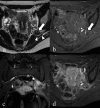Extragenital endometriosis: assessment with MR imaging. A pictorial review
- PMID: 26846303
- PMCID: PMC4846200
- DOI: 10.1259/bjr.20150672
Extragenital endometriosis: assessment with MR imaging. A pictorial review
Abstract
Endometriosis is a gynaecologic disease characterized by endometrial tissue outside the uterine cavity. Commonly it affects the pelvic organs. When endometrial nodules or plaques are localized in sites other than the uterus or ovaries, it is termed extragenital endometriosis. Adequate pre-operative assessment is essential for treatment planning. MRI is a non-invasive method with high spatial resolution that allows the multiplanar evaluation of genital and extragenital endometriosis. Herein, we present a pictorial review of a variety of extragenital endometriosis cases, all of which can be encountered in clinical practice.
Figures















Similar articles
-
Beyond the boundaries-endometriosis: typical and atypical locations.Curr Probl Diagn Radiol. 2011 Nov-Dec;40(6):219-32. doi: 10.1067/j.cpradiol.2011.01.003. Curr Probl Diagn Radiol. 2011. PMID: 21939816
-
[Relevance of MRI for endometriosis diagnosis].Rofo. 2011 May;183(5):423-31. doi: 10.1055/s-0029-1245997. Epub 2011 Jan 18. Rofo. 2011. PMID: 21246473 Review. German.
-
[Magnetic resonance imaging in the diagnosis of different forms of endometriosis].Vestn Rentgenol Radiol. 2003 Jul-Aug;(4):45-59. Vestn Rentgenol Radiol. 2003. PMID: 14619398 Russian.
-
[Ureteric and bladder involvement of deep pelvic endometriosis. Value of multidisciplinary surgical management].Prog Urol. 2006 Nov;16(5):588-93. Prog Urol. 2006. PMID: 17175957 French.
-
Extragenital endometriosis--a clinicopathological review of a Glasgow hospital experience with case illustrations.J Obstet Gynaecol. 2004 Oct;24(7):804-8. doi: 10.1080/01443610400009568. J Obstet Gynaecol. 2004. PMID: 15763794 Review.
Cited by
-
Rectal endometriosis presenting as toxic megacolon.Autops Case Rep. 2021 Sep 3;11:e2021319. doi: 10.4322/acr.2021.319. eCollection 2021. Autops Case Rep. 2021. PMID: 34540725 Free PMC article.
-
Estrogen is essential but not sufficient to induce endometriosis.J Biosci. 2017 Jun;42(2):251-263. doi: 10.1007/s12038-017-9687-4. J Biosci. 2017. PMID: 28569249
-
Real world perspectives on endometriosis disease phenotyping through surgery, omics, health data, and artificial intelligence.NPJ Womens Health. 2025;3(1):8. doi: 10.1038/s44294-024-00052-w. Epub 2025 Feb 6. NPJ Womens Health. 2025. PMID: 39926583 Free PMC article. Review.
-
Advances in Imaging for Assessing Pelvic Endometriosis.Diagnostics (Basel). 2022 Nov 26;12(12):2960. doi: 10.3390/diagnostics12122960. Diagnostics (Basel). 2022. PMID: 36552967 Free PMC article. Review.
-
Therapeutic Potential of Natural Resources Against Endometriosis: Current Advances and Future Perspectives.Drug Des Devel Ther. 2024 Aug 21;18:3667-3696. doi: 10.2147/DDDT.S464910. eCollection 2024. Drug Des Devel Ther. 2024. PMID: 39188919 Free PMC article. Review.
References
Publication types
MeSH terms
LinkOut - more resources
Full Text Sources
Other Literature Sources
Medical

